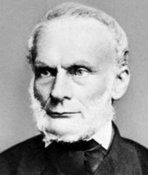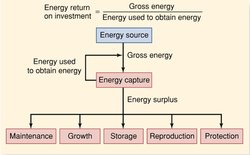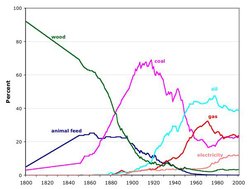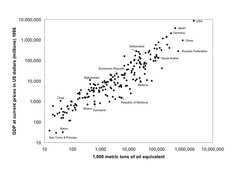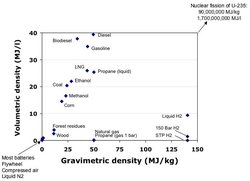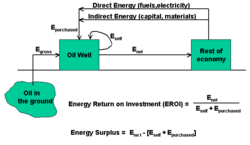Fundamental principles of energy
| Topics: |
Contents
- 1 IntroductionThe concept of energy (Fundamental principles of energy) as we now understand it—a conserved quantity that represents the ability to do work—has been with us for less than two centuries. Yet its central role in human affairs dates to the time of the first humans, its role in shaping the physical and biological nature of the Earth dates to the planet's birth, and the story of Big Bang itself is told in terms of energy and matter.
- 2 Energy cannot be created, destroyed or recycled[1]
- 3 Life depends on the Sun
- 4 Earth's energy balance determines climate
- 5 Natural selection operates on energy strategies[2]
- 6 Transitions in energy systems transform culture
- 7 Energy drives economic growth
- 8 Control of energy causes violent conflict
- 9 Energy systems impair ecosystem and human health
- 10 Energy quality varies among sources
- 11 Net energy is an ultimate constraint
- 12 Notes (Fundamental principles of energy)
- 13 Further reading
IntroductionThe concept of energy (Fundamental principles of energy) as we now understand it—a conserved quantity that represents the ability to do work—has been with us for less than two centuries. Yet its central role in human affairs dates to the time of the first humans, its role in shaping the physical and biological nature of the Earth dates to the planet's birth, and the story of Big Bang itself is told in terms of energy and matter.
Advances in our understanding of energy have produced unparalleled transformations of society, as exemplified by James Watt’s steam engine and the discovery of oil and its use as a fuel. Formalization of the concept of energy and identification of the laws governing its use by 19th century physical scientists such Mayer and Clausius are cornerstones of modern science.
The study of energy has played a pivotal role in understanding the creation of the universe, the origin of life, the evolution of human civilization and culture, economic growth and the rise of living standards, war and geopolitics, and significant environmental change at local, regional and global scales.
Virtually every discipline investigates some aspect of energy, including history, anthropology, public policy, international relations, human and ecosystem health, economics, technology, physics, geology, ecology, business management, environmental science, and engineering.
Physicists and economists would no doubt debate the 10 most important implications of energy for their respective disciplines; carving just 10 principles out across all fields means that important ideas will be left out. Nonetheless, the link between energy and human well-being is so deep and so compelling that a list of core principles forms the seed for important discussion and debate.
With that said, here are 10 fundamental concepts about energy. While not in any particular order, which could be debated, the first two are probably the most fundamental and from which the remaining concepts build from.
Energy cannot be created, destroyed or recycled[1]
In 1865, the German physicist Rudolf Clausius investigated energy use by steam engines. The steam engine was a key driving force behind the Industrial Revolution because it was the first practical, affordable, and reliable machine that could convert the chemical energy in fossil fuels to mechanical energy. In addition to mechanical work, the engine also generates waste heat, energy released from the boiler and other engine parts in the form of heat. The term "waste" refers to the fact that some of the chemical potential energy in the fuel is not converted to useful work, but instead is released to the general surroundings of engine.
Clausius' experiments demonstrated two important laws of energy use. We now know that these laws of thermodynamics (from the Greek therme, meaning "heat" and dynamis, meaning "power") apply to every type of energy conversion. The first law of thermodynamics states that there is no increase or decrease in the quantity of energy in any energy conversion. The total energy input to an energy converter and the total energy output always are equal. In the case of the steam engine, the quantity of chemical potential energy in the fuel is equal to the sum of the mechanical energy and waste heat produced by the engine. This law applies to all energy conversions. For example, the amount of chemical potential energy in the food energy you consume is equal to the sum of the mechanical or electrical work done by your body (walking, thinking, etc.) plus the heat generated. Similarly, the amount of chemical potential energy in gasoline is equal to the sum of the work done by a car engine, its gadgets (e.g., air conditioner and CD player) plus the waste heat generated.
The first law of thermodynamics means that the quantity of energy remains constant in every conversion process. But Clausius' experiments with steam engines revealed another fundamental law of energy conversion: the quality of energy also changes. The second law of thermodynamics states that in all energy conversion processes energy loses its ability to do work and its inherent quality decreases. The energy that the steam engine converts from chemical potential energy to waste heat has lost its ability to do useful work; it is degraded in quality. The chemical potential energy in these fuels to converted to a lower quality heat, so their ability to do work literally is "used up" when they are burned in power plants and cars.
The second laws also tells us that there is a direction to real world processes, namely, things move from a highly ordered state to a disordered state. This is the principle of entropy. Entropy is the degree of order or organization in a system. Clausius’ work applied the concept to energy, but since then scientists have found that the same principle also applies to all changes in materials. Matter or energy that are highly organized or highly ordered have low entropy. Matter or energy that are highly disorganized or random have high entropy.
The second law of thermodynamics means that orderly structures, patterns, and arrangements of energy and materials tend to drift towards disorder by themselves. This movement towards a greater state of entropy occurs without outside interference. Thus, the tendency for energy and materials to move from an ordered, low entropy state to a disordered, high entropy state is a spontaneous process. An automobile engine spontaneously converts the low entropy, chemical potential energy of gasoline to forward motion and waste heat. Similarly, the low entropy, chemical potential energy of wood is spontaneously converted to heat in your fireplace.
The entropy law and the notion of spontaneous changes also applies to materials. If you place a single drop of ink in a glass of water, the ink will disperse spontaneously throughout the water. Eventually, the ink will be evenly mixed and the water will take on a dark hue. If you leave a bicycle outside, it spontaneously crumbles into a pile of rust as the molecules of iron begin to flake off, fall to the ground, or are dispersed by the wind. Junkyards and landfills are testaments to the spontaneous tendency towards disorder described by the second law. They are full of materials that have broken down or worn out due to the forces of entropy.
Disordered, high entropy energy and materials do not organize back to a low entropy, ordered state by themselves; human processing or some other outside intervention is required to achieve this. The movement towards a greater state of organization is called a nonspontaneous process. We know that the heat generated by the fireplace will not spontaneously reorganize itself into wood. The atoms of ink will not reassemble themselves into a single drop, nor will a pile of rust re-assemble itself back into a new bicycle. However, you could vacuum up the rust particles and transport them back to a factory where they could be melted, refined, and ultimately fashioned into a new bicycle. That process is nonspontaneous because it would not occur without a significant investment of time and energy.
The laws of thermodynamics are a cornerstone of modern science and engineering. They are essential to the design of nearly every industrial process and device, they inform us about the structure and function of [[ecosystem]s], the direction of chemical reactions, the evolution of life, and they underpin our understanding of how energy from the sun and heat from the Earth's core drive the planet's biogeochemical cycles. The laws of thermodynamics have also been applied to economic systems where they set broad but immutable constraints on human economic aspirations.
Life depends on the Sun
 Solar radiation is the energy source for life. (Source: NASA)
Solar radiation is the energy source for life. (Source: NASA) Energy from the sun—past and present—create the conditions necessary for life to exist and for human material well-being. The Sun underpins life on Earth in innumerable ways. It powers photosynthesis, the conversion of light energy to chemical energy and its subsequent storage in the bonds of sugar. This process occurs in plants and some algae that use only solar radiation, carbon dioxide (CO2), and water (H2O) to make sugar. Photosynthesis is arguably the most important energy conversion process on Earth because the chemical energy it yields is the base of food chains that sustain the overwhelming majority of other life forms.
Energy received from the Sun drives many of planet's biogeochemical cycles, including the water cycle, the carbon cycle, and the nitrogen cycle. These material cycles provide nutrients for plants, clean water for human use, and otherwise support the array of environmental services that sustain life. These physical processes strongly influence the course of evolution, the distribution and abundance of life and the differing human cultures.
Fossil fuels—oil, natural gas, coal, oil sands—are derived from the Sun. These fuels are the lifeblood of industrial civilization, accounting for about 85% of global energy use. The formation of oil and natural gas began hundreds of millions ago with the life and then death of marine phytoplankton, bacteria, and other organisms. Their organic material was ultimately buried deep in the Earth's crust under low oxygen conditions where high temperature and pressure transformed them into the fuels we know them as today. Coal formation was favored in certain coastal swamps and bogs where plant material accumulated after a drop in sea level to form large, thick layers of organic matte rich in cellulose and lignin, materials characteristic of higher plants. This material was ultimately buried through geological shifting leading to the coal deposits we use today. As this discussion indicates, the formation of fossil fuels depends not only on energy from then Sun to supply the raw materials, but also on heat from the Earth's core to transform the plant material.
Thus, whether it is solar radiation warming your face today, or that which produced a diatom 300 million years ago, the Sun is the ultimate source of life on the planet.
Earth's energy balance determines climate
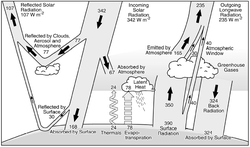 Numbers are in watts per square meter of Earth's surface, and some may be uncertain by as much as 20%. The greenhouse effect is associated with the absorption and re-radiation of energy by atmospheric greenhouse gases and particles, resulting in a downward flux of infrared radiation from the atmosphere to the surface (back radiation) and therefore in a higher surface temperature. Note that the total rate at which energy leaves Earth (107 W/m2 of reflected sunlight plus 235 W/m2 of infrared [long-wave] radiation) is equal to the 342 W/m2 of incident sunlight. Thus Earth is in approximate energy balance in this analysis. (Source: Trenberth, 2004)
Numbers are in watts per square meter of Earth's surface, and some may be uncertain by as much as 20%. The greenhouse effect is associated with the absorption and re-radiation of energy by atmospheric greenhouse gases and particles, resulting in a downward flux of infrared radiation from the atmosphere to the surface (back radiation) and therefore in a higher surface temperature. Note that the total rate at which energy leaves Earth (107 W/m2 of reflected sunlight plus 235 W/m2 of infrared [long-wave] radiation) is equal to the 342 W/m2 of incident sunlight. Thus Earth is in approximate energy balance in this analysis. (Source: Trenberth, 2004) The climate of Earth is determined by the balance between energy entering and leaving the atmosphere (Atmosphere layers). The global average temperature is a simple function of its energy balance: the quantity of energy reaching the planet relative to the quantity exiting the planet. The Earth's energy balance distributes incoming solar radiation in such as way to produce an average annual temperature of nearly 15 °C (59 °F), ideal for life to flourish. Among many other vital functions, the Earth’s energy balance heats the atmosphere and earth surface to temperatures far above the minus 270°C (254 °F) of deep space.
The Earth intercepts about 1.7 x 1017 watts (W) of solar energy. By comparison, the capacity of all the electric power generation stations in the world is about 3.7 terawatts (TW), or 3.7 x 1012 watts. Thus, the Sun delivers nearly 46,000 times more energy than the world’s electric power consumption. About 30% of incoming solar energy is scattered or reflected back to space by the atmosphere; the remainder is is absorbed by the Earth's surface and atmosphere. All heated objects (those above absolute zero degrees) release electromagnetic radiation (also known as thermal radiation). Since the Earth is surrounded by empty space with an effective temperature of only 3 to 4 degrees K, the potential for outgoing radiation from the Earth is high. This energy is referred to as outgoing radiation. An object will continue to warm if the incoming radiation exceeds the outgoing radiation.
If the Earth were a blackbody (a body that absorbs all radiation that falls on it), its equilibrium temperature would be -18 °C. In reality, the Earth is much warmer than that because "greenhouse gases" such as carbon dioxide and water vapor absorb some of the outgoing radiation, thereby warming the atmosphere, analogous to the effects of a greenhouse. Without the greenhouse effect, the Earth would be 33 ºC cooler; that is, the average temperature of the Earth would be about -18 ºC as opposed to 15 ºC. Note that the greenhouse effect does not put the Earth’s energy budget “out of balance.” The heat is held temporarily in the atmosphere, and then eventually is released from the atmosphere as long wavelength infrared energy.
The global average air temperature near the Earth's surface rose about 0.74 °C (1.33 °F) during the hundred years ending in 2005. The Intergovernmental Panel on Climate Change (IPCC) concludes "most of the observed increase in globally averaged temperatures since the mid-twentieth century is very likely due to the observed increase in anthropogenic greenhouse gas concentrations" via the greenhouse effect. Human activity, such as land use change and the combustion of fossil fuels, release greenhouse gases and affect the amount of energy reflected by the planet. The future rate and magnitude of climate change thus depends in part on economic growth, people's behavior, technological change, government polices and other forces that determine energy use. Understanding the important details of this complex system is one of the great challenges facing the world’s scientific community.
Natural selection operates on energy strategies[2]
Natural selection operates on evolutionary strategies that capture and allocate energy among competing uses. Every living organism must use energy for six purposes; maintenance, growth, storage, reproduction, protection, and obtaining more energy. The natural world is a dazzling array of different strategies for accomplishing these tasks. Endotherms such as mammals maintain a preferred body temperature with heat generated by their own metabolic processes, while ectotherms such as lizards obtain their body heat from the environment. Autotrophs (Greek for “self feeders”) such as green plants produce their own food via photosynthesis, while heterotrophs (Greek for “other feeders”) get their food by consuming other organisms. Humans store energy in the form of fat, while most trees store excess amounts of energy generated during the summer in their roots. Elephants produce one offspring and invest substantial energy in rearing it, while most fish produce huge numbers of offspring an invest little energy in parenting.
The desirability of various strategies for obtaining energy from the environment and allocating it among different uses is determined by natural selection. Strategies that work are rewarded while strategies that do not work are punished. If a strategy works, an individual will have sufficient supplies of energy and will allocate it in ways that allow the individual to produce many offspring that survive and prosper. If the strategy is inherited by the offspring, the number of individuals that follow this strategy will increase in the next generation. If a strategy does not work, the individual will produce few offspring and these offspring will have a small probability of survival. As a result, the number of individuals that follow the strategy will decrease in the following generation.
If the relative success of a strategy persists for many generations, the strategy that generates the most energy and allocates it among maintenance, growth, storage, reproduction, and protection in a way that generates the greatest number of successful offspring will prevail. Other strategies will appear, but they will fail and disappear.
The role of natural selection in "choosing" strategies is illustrated by asking the question, why breathe oxygen? One pathway allows organisms to convert food to energy without oxygen, which is termed anaerobic respiration. Another pathway uses oxygen to convert food to energy, which is termed aerobic respiration. Most organisms on the planet use aerobic respiration. Why? An organism that respires a molecule of glucose anaerobically obtains 47 units of energy while the aerobic pathway generates 686 units of energy. Given the same amount of food, the aerobic organism has 15 times more energy available. All other things being equal, this difference allows the aerobic organism to expend greater efforts to maintain itself, to grow, to reproduce, to protect itself, and to obtain more food. Based on this advantage, organisms that depend mainly on aerobic respiration have been able to out compete organisms that are capable of anaerobic respiration only in environments where oxygen is present. As a result, aerobic organisms are the predominant form of life on the planet.
Transitions in energy systems transform culture
Changes in energy conditions generate sweeping changes in society, including the transformation of culture and rise and fall of civilizations. Fire transformed human life by providing light, warmth, cooking, heating and ultimately the ability to smelt and forge metals, and to bake bricks, ceramics, and lime. Fire became the basis for human culture long before the Bronze Age, and ultimately all Western culture. However, up until a couple of centuries ago, the fire typically was produced by burning 'recent' carbon stored in biomass.
The changes wrought by fossil fuels exceeded even those produced by the introduction of fire. The rapid expansion of the human population and its material living standard over the past 200 years could not have been produced by direct solar energy and wood being converted by plants, humans and draft animals. Advances in every human sphere—commerce, agriculture, transportation, the military, science and technology, household life, health care, public utilities—were driven directly or indirectly by the changes in society's underlying energy systems.
In the coming decades, world oil production will peak and then begin to decline, followed by natural gas and eventually coal production. There is considerable debate as to when the peak in world oil production will occur. Global oil discovery peaked in the late 1960s, and since the mid-1980s oil companies have added less oil to proved reserves than we have consumed. On the other hand, the rate of oil production in the recent past has inched upwards. In fact, the 74.5 million barrels of oil and condensate produced per day in the world in January 2008 was an all-time monthly record according to data from the U.S. Energy Information Administration.
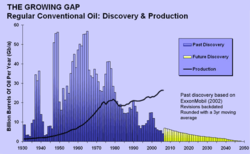 The rate of global oil production compared to the rate at which oil is added to global proved reserves. (Source: ASPO-Ireland)
The rate of global oil production compared to the rate at which oil is added to global proved reserves. (Source: ASPO-Ireland) The precise nature of the energy transition is uncertain, but its sheer magnitude will dwarf the wood-to-coal transition of the 19th century. More importantly, the next energy transition will occur under a very different set of conditions. Solar energy and wind are inherently lower quality than fossil fuels, and the global environmental frontier is closed. In addition, future energy systems must supply adequate energy to support an acceptable living standard in wealthy nations, and they must supply energy sufficient to relieve the abject poverty of the world's poorest. It is likely that a future sustainable energy society will function quite differently from that seen in today's wealthy nations.
Thus, regardless of who is "right" in regards to the timing of the peak, the fact there will be a peak in the coming decades presents humanity with a risk management challenge that is unprecedented in history. The development of technologies to replace oil--whether on the supply side in the form of new sources or on the demand side in the form of more efficient end use and altered behaviors--have very long lead times. It is unlikely that market forces alone will produce a socially optimum response to the peak in oil production. Policy responses are needed that are vastly more potent than current policies in terms of foresight, pace, and financial support.
Energy drives economic growth
The economic well-being of nations and individuals depend largely on the amount of energy they use. Rapid economic growth is one of the defining characteristics of modern society. It is a principal goal of nearly every national government in the world. Gross world product, the total value of all goods and services produced, increased from $7 trillion in 1950 to about $70 trillion in 2007. Annual income per person increased by nearly factor of 5 in this period.
At root, economic growth is a physical process: energy is used to transform materials into useful goods and services. At an aggregate level, therefore, it is not surprising that there is a strong relationship between the quantity of energy a nation uses and the size of its economy, i.e., the quantity of wealth it produces. Therefore it follows that the largest economies (U.S., China, European Union, Japan) use considerably more energy than smaller economies. A similar spread appears if one compares per capita GDP and energy use, although some nations use energy more efficiently than others.
Given the importance of energy, it is not surprising that energy prices have an important effect on almost every major barometer of macroeconomic performance. For example, increases in energy prices contribute to recessions such as what happened in 1979-1980. Oil prices are an important driver behind stock price movements, and they are also key determinants of inflation and unemployment.
 Two Sudanese women carrying fuelwood. (Source: Sudan Tribune)
Two Sudanese women carrying fuelwood. (Source: Sudan Tribune) Access to energy services is a key component of alleviating poverty and an indispensable element of sustainable human development. Without access to modern, commercial energy, poor countries can be trapped in a vicious circle of poverty, social instability and underdevelopment.
During the past twenty-five years, electricity supplies have been extended to 1.3 billion people living in developing countries. But between 1.5 and 2 billion have no access to electricity and more than 2 billion people rely on traditional biomass such as wood, agricultural residues and dung for cooking and heating. More than 99 percent of people without electricity live in developing regions, and four out of five live in rural areas of South Asia and sub-Saharan Africa.
Without modern energy services, millions of women and children face serious illness or premature death; basic social goods like health care and education are more costly in both real and human terms, and economic development is harder to sustain. The services that energy enables, such as electricity, can create conditions for improved living standards, especially in areas of public health, education, and family life.
Control of energy causes violent conflict
Struggle over scarce supplies of energy has generated violent conflict throughout human history. Since the time when humans first harnessed energy flows in nature, they have fought bitterly for control of those regions of the Earth that grant access to energy flows and storages. For most of human civilization, the most important sources of work were people and draft animals that were powered by renewable energy: the products of photosynthesis. Thus, the eternal struggle to capture the "land of thy enemy" was motivated in part by the increased ability to feed horses and armies, which, in turn, provided greater means to capture other natural resources such as timber, water, and minerals.
The initial transition to inanimate forms of energy (wind and water) changed the object of the energy struggle but not its importance. Early industrial centers and trade relied on water for power and transportation. Water-powered factories and mills required precise locations on rivers, and the (free) mechanical energy of the flowing water of rivers provided a critical transportation link between resource-rich hinterlands and bustling urban centers of manufacture and trade. Control of rivers and watersheds thus became the focal points of military campaigns.
The sailing ship was an especially transformative energy conversion system. Prior to the sailing ship, ocean transport depended on vessels powered by human labor, an inefficient mode due to the low power output of the human body and the space and weight occupied by the food required to fuel the laborers. The energy source for the sailing ship was free, and, under the right conditions, very powerful, and led to a transformation of the world economic and geopolitical order. Masts become a vital necessity to nations. When the Dutch cut-off English access to the forests of the Baltic countries in 1654, England turned to the colonies in America to harvest its great forests of white pine. The old English sign of naval property, the "Broad Arrow," appeared on all trees over twenty-four inches in diameter by 1691. Tensions over timber supply escalated as colonists' domestic need for timber grew, and were a major factor leading to the outbreak of the Revolutionary War.
Conflict over energy reached new heights in the oil era because the economic and geopolitical stakes were much higher. World War I was the first global conflict in which energy played a central role. The war machine was a combination of traditional technology (people and horses) with oil-based mechanization (planes and tanks). Both the Entente and Central powers knew that control of oil was a key to victory, and they wanted access to key oil regions when the political boundaries were redrawn by the victors. Case in point is the Caspian Sea basin, and especially Baku, the birthplace of the international oil industry. At various points in the war, Armenians and British forces defended Baku oil fields for Russia against German and Turkish invaders. In 1920, when the Bolsheviks captured Azerbaijan, all private property- including oil wells and factories - was confiscated. The Republic's entire oil industry was subsequently directed toward the purposes of the Soviet Union, including a tremendous output of oil for the World War II effort.
Oil was central to the strategy and execution of World War II. In response to Japan's invasion of China, the U.S. cut off oil exports to Japan in July 1941. Without domestic sources and thus starved for oil, Japan invaded the oil rich Indonesian islands. These tensions were a direct contributor to the attack on Pearl Harbor and the U.S entry into the war.
Hitler declared war on the Soviet Union in 1941 in part to secure oil for his war machine. He launched Operation Blau, a campaign designed to protect Nazi oilfields in Romania while securing new ones in the Caucasus. To do this he needed control of Stalingrad (now Volgograd). The ensuing Battle of Stalingrad, conducted between between August 21, 1942 and February 2, 1943, is viewed as one of the turning points of the war in the European Theater, and is among the bloodiest battles in human history, with combined casualties estimated to be above 1.5 million.
The Gulf War or Persian Gulf War (August 1990 to February 1991) centered on the control of oil and the power that flows from that control. Iraq's invasion of Kuwait gave it control of more than 220 billion barrels of oil, an amount that rivaled the reserves of Saudi Arabia, the worlds largest holder of reserves. This would have given Iraq significant influence in the world oil market, a position that the U.S. and other oil consuming nations views as untenable. The U.S. led invasion centered around the return Kuwait to the control of the Emir of Kuwait and with it control of that nation's oil holdings.
Energy systems impair ecosystem and human health
 The increase in CO2 concentrations in the atmosphere. (Source: Keeling, C.D. and T.P. Whorf. 2005. Atmospheric carbon dioxide records from sites in the SIO air sampling network. In Trends: A Compendium of Data on Global Change. Carbon Dioxide Information Analysis Center, Oak Ridge National Laboratory, U.S. Department of Energy, Oak Ridge, Tenn., U.S.A.)
The increase in CO2 concentrations in the atmosphere. (Source: Keeling, C.D. and T.P. Whorf. 2005. Atmospheric carbon dioxide records from sites in the SIO air sampling network. In Trends: A Compendium of Data on Global Change. Carbon Dioxide Information Analysis Center, Oak Ridge National Laboratory, U.S. Department of Energy, Oak Ridge, Tenn., U.S.A.) The impairment of human and ecosystem health is closely associated with the capture and use of energy at local, regional and global scales. The extraction, processing and use of energy are major sources of environmental stress at global, regional, and local levels. Atmospheric releases from fossil fuel energy systems comprise 64 per cent of global anthropogenic carbon dioxide emissions from 1850-1990, 89 per cent of global anthropogenic sulfur emissions from 1850 to 1990, and 17 per cent of global anthropogenic methane emissions from 1860-1994. Fossil energy combustion also releases significant quantities of nitrogen oxide. Power generation using fossil fuels, especially coal, is a principal source of trace heavy metals such as mercury, selenium, and arsenic. These emissions drive a range of global and regional environmental changes, including global climate change, acid deposition, and urban smog.
Some argue that the increases in CO2 concentrations may be simply part of the natural variations that do occur. However, the current level of CO2 concentrations in the atmosphere of approximately 380 ppm are well in excess of the range seen from the ice core samples which map the concentration over the past 400,000 years or so.
Upstream energy sectors also have significant local impacts on the environment. Coal mining disturbs vast areas of natural habitat. In the U.S., for every ton of coal mined, 6 additional tons of overburden and waste are generated. The exploration for and extraction of oil and natural gas can have significant impacts, particularly in sensitive ecosystems such as wetlands and tundra, and it releases hazardous and toxic wastes from drilling and field processing operations. While a potentially renewable source of energy, hydropower development can have significant environmental and social costs depending on its location and mode of development. Between 30 and 60 million people—the majority residing in China and India—have been displaced by large dams; about 500,000 square kilometers of land—almost the size of France—are covered by large hydroelectric reservoirs. Much of this is river valley land that supports fertile farmland and diverse forest and wetland ecosystems.
More than half of the world’s population rely on dung, wood, crop waste or coal to meet their most basic energy needs. Cooking and heating with such solid fuels on open fires or stoves without chimneys leads to indoor air pollution. This indoor smoke contains a range of health-damaging pollutants including small soot or dust particles that are able to penetrate deep into the lungs. In poorly ventilated dwellings, indoor smoke can exceed acceptable levels for small particles in outdoor air 100-fold. Exposure is particularly high among women and children, who spend the most time near the domestic hearth. The World Health Organization (WHO) describes indoor air pollution as the 8th most important risk factor and responsible for 2.7% of the global burden of disease . Globally, indoor air pollution from solid fuel use is responsible for 1.6 million deaths due to pneumonia, chronic respiratory disease and lung cancer, with the overall disease burden exceeding the burden from outdoor air pollution five fold.
Energy quality varies among sources
Although all forms of energy can be measured by their heat content, the usefulness of a heat unit of energy varies greatly among energy types. The world uses about 500 exajoules (500×1018 joules) of energy each year. This total is generated by adding together the heat content, measured in joules, of many forms of energy: crude oil, natural gas, coal, geothermal, biomass, and electricity from wind, solar, nuclear power, and other sources. The advantage of the content approach is that it uses a simple and well-defined accounting system based on the conservation of energy, and the fact that thermal equivalents are easily and uncontroversially measured. This approach underlies most methods of energy accounting in economics and ecology.
Despite its widespread use, summing different energy types by their heat units embodies a serious flaw: it ignores qualitative differences among forms of energy. Simply put, not all joules are equal in terms of their potential to meet human needs. Energy quality refers to differences in the ability of a unit of energy to produce goods and services for people. Energy quality is determined by a complex combination of physical, chemical, technical, economic, environmental and social attributes that are unique to each form of energy. These attributes include gravimetric and volumetric energy density, power density, emissions, cost and efficiency of conversion, financial risk, amenability to storage, risk to human health, spatial distribution, intermittency, and ease of transport.
For example, the substitution of coal for biomass and then petroleum for coal were shifts to more concentrated forms of energy. Solid and liquid fossil fuels have much larger mass densities than biomass fuels, and and an even greater advantage in terms of volumetric densities. The preeminent position of liquid fuels derived from crude oil in terms of its combined densities is one reason why it transformed the availability, nature and impact of personal and commercial transport in society. The lower energy density of biomass (12-15 MJ/kg) compared to crude oil (42 MJ/kg) means that replacing the latter with the former will require a significantly larger infrastructure (labor, capital, materials, energy) to produce an equivalent quantity of energy.
Accounting for energy quality is essential to the understanding of the relation between energy and human well-being. For example, the decline in the energy/GDP ratio in the major industrial nations over the past several decades is due in large part to the shift from coal to oil, natural gas, and primary electricity. Similarly, nations that use high quality energy sources, such as primary electricity (Japan, Sweden), tend to use fewer joules to produce a dollar's worth of GDP than nations that rely heavily on solid and liquid fuels (Russia and Poland).
Net energy is an ultimate constraint
The quantity of energy obtained relative to the quantity used to obtain it sets an absolute cut-off point to measure the supply of energy. In accordance with the second law of thermodynamics, the continuous flow of oil, coal, and other fuels used to run society is converted into low quality, unavailable energy ("waste heat"). This means that society must continuously extract new energy from the environment, an activity that itself requires energy to accomplish. Energy is used to lift oil to the surface, excavate coal pits, manufacture wind turbines, etc. Surplus or net energy is the term that describes the amount of energy delivered to society, net of the energy used to deliver it. Energy return on investment (EROI) is the ratio of these quantities: the amount of energy delivered to the amount used in the delivery process.
Economies with access to energy sources with a large energy surplus have greater potential for economic expansion and/or diversification than those with access to lower quality fuels. The history of the expansion of human civilization and its material standard of living is directly linked to successive access to and development of fuel sources with increasingly greater energy surpluses. The transitions from animate energy sources such as plant, biomass, and draft animals, to wind and water power, to fossil fuels and electricity enabled increases in per capita output due to increases in the quantity of fuel available to produce non-energy goods. The transition to higher surplus fuels also enabled social and economic diversification as increasingly less available energy was used in the energy securing process, meaning more fuel was available to support non-extractive activities.
An EROI = 1 is an absolute cutoff point for an energy source, the point at which as much energy is used to deliver a unit of energy as that unit yields. The EROI for crude oil has declined over time, and may continue to do so as the resource base is depleted. Smaller, deeper, and more remote fields require more energy to develop. Alternatives to crude oil such as ethanol from corn and coal liquefaction deliver a significantly lower EROI because a significant amount of energy is needed to process the feedstock itself (corn or coal). Economic growth and rising standards of living may be more difficult to maintain than they were 50 years ago when wealth was produced by the massive energy surplus associated with the discovery of the Earth's great oil fields in the first half of the twentieth century.
Notes (Fundamental principles of energy)
Further reading
Energy laws:
- Nave, Carl R., Hyperphysics, Department of Physics and Astronomy, Georgia State University.
- Weisstein, Eric W. Eric Weisstein's World of Physics.
Life and solar energy:
- What is photosynthesis?, Center for Bioenergy & Photosynthesis, Arizona State University, Accessed 18 March 2008.
- How fossil fuels were formed, U.S. Department of Energy, Accessed 18 March 2008.
Earth's energy balance:
- Ritter, Michael E. Radiation and energy balance of the earth system, In: The Physical Environment: an Introduction to Physical Geography, Accessed 18 March 2008.
- Trenberth, Kevin E. Earth's Energy Balance. In: Cutler J. Cleveland, Editor(s)-in-Chief, Encyclopedia of Energy, Elsevier, New York, 2004, Pages 859-870.
- Earth's energy balance (This Encyclopedia)
Energy and Evolution:
- Kay, James J. About....... thermodynamics and ecology, University of Waterloo, Accessed 18 March 2008.
- Lotka, Alfred J. (1922) Contribution to the energetics of evolution [PDF]. Proc Natl Acad Sci, 8: pp. 147–51.
Energy Transitions:
- Smil, Vaclav. 2006. 21st century energy: Some sobering thoughts. OECD Observer 258/59: 22-23.
- Cleveland, Cutler J. Energy transitions past and present (This Encyclopedia), Accessed 15 March 2008.
- Grubler, Arnulf, Energy transitions (This Encyclopedia), Accessed 8 March 2008.
- Data for historical energy use are derived from these sources:
- Dewhurst, J. Frederick and Associates. 1955 America's Needs and Resources. (New York: Twentieth Century Fund).
- Schurr, S. H., and B. C. Netschert. Energy in the American Economy, 1850-1975. Baltimore, Md.: Johns Hopkins University Press, 1960.
- Energy Information Administration, U.S. Department of Energy, Annual Energy Review, Accessed 18 November 2007.
- Carter, Susan B. Scott Sigmund Gartner, Michael R. Haines, Alan L. Olmstead, Richard Sutch and, Gavin Wright (Editors). 2006. The Historical Statistics of the United States-Millennial Edition (Cambridge University Press, Cambridge, UK).
Energy and the economy:
- Kaufmann, Robert K. 1992. A Biophysical analysis of the energy/real GDP ratio: implications for substitution and technical change. Ecological Economics 6(1) 35-56.
- Stern, David I. and Cutler J. Cleveland. 2004. Energy and Economic Growth, Department of Economics, Rensselaer Polytechnic Institute, Accessed 18 March 2008.
- United Nations Environment Programme, Energy for Sustainable Development. Accessed 18 March 2008.
Energy and Conflict:
- Arima, Yuichi, The Way to Pearl Harbor: US vs Japan, Inventory of Conflict and Environment, American University, Accessed 15 March 2008.
- Grau, Lester W., Hydrocarbons and a New Strategic Region: The Caspian Sea and Central Asia, Military Review, May-June 2001.
- Klare, Michael, Blood and Oil: The Dangers and Consequences of America’s Growing Dependency on Imported Petroleum, (New York: Metropolitan Books, 2004; paperback, Owl Books, 2005)
- Yergin, Daniel. The Prize: The Epic Quest for Oil, Money & Power. Simon & Schuster, 1991.
Energy, the environment and human health:
- World Health Organization, Health Impacts of indoor air pollution, Accessed 18 March 2008.
- International Energy Agency, Energy and Climate Change, Accessed 18 March 2008.
- Impacts of air pollution on local to global scale (This Encyclopedia).
- World Health Organization, Health Impacts of indoor air pollution, Accessed 18 March 2008.
Energy quality:
- Energy quality (This Encyclopedia).
- Cleveland, Cutler J., David I. Stern, and Robert K. Kaufmann. Aggregation and the Role of Energy in the Economy Ecological Economics, 32: 301-317 (2000).
Net energy:
- Energy return on investment, (This Encyclopedia).
- Net energy analysis (This Encyclopedia).
- Ten fundamental principles of net energy (This Encyclopedia).

